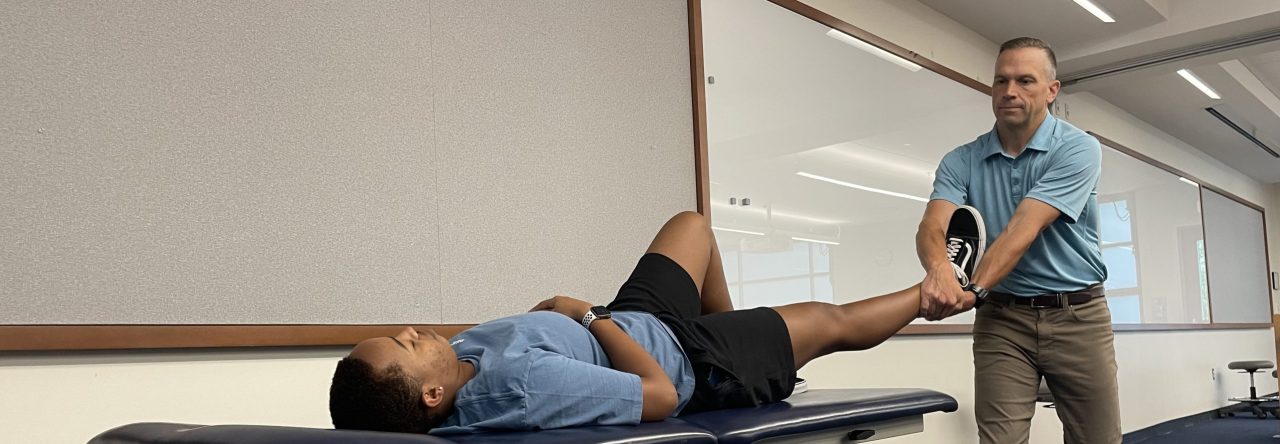Author Names
Alonso-Perez, J., Lopez-Lopez, A., Touche, R., Lerma-Lara, S., Suarez, E., Rojas, J., Bishop, M., Villafane, J., Fernandez-Carnero, J.
Reviewer Name
Jennifer Burris, SPT
Reviewer Affiliation(s)
Duke University Doctor of Physical Therapy Program APTA
Paper Abstract
Objective: The purpose of this study was to evaluate the extent to which psychological factors interact with a particular manual therapy (MT) technique to induce hypoalgesia in healthy subjects. Methods: Seventy-five healthy volunteers (36 female, 39 males), were recruited in this double-blind, controlled and parallel study. Subjects were randomly assigned to receive: High velocity low amplitude technique (HVLA), joint mobilization, or Cervical Lateral glide mobilization (CLGM). Pressure pain threshold (PPT) over C7 unilaterally, trapezius muscle and lateral epicondyle bilaterally, were measured prior to single technique MT was applied and immediately after to applied MT. Pain catastrophizing, depression, anxiety and kinesiophobia were evaluated before treatment. Results: The results indicate that hypoalgesia was observed in all groups after treatment in the neck and elbow region (P < 0.05), but mobilization induces more hypoalgesic effects. Catastrophizing interacted with change over time in PPT, for changes in C7 and in manipulation group. Conclusions: All the MT techniques studied produced local and segmental hypoalgesic effects, supporting the results of previous studies studying the individual interventions. Interaction between catastrophizing and HVLA technique suggest that whether catastrophizing level is low or medium, the chance of success is high, but high levels of catastrophizing may result in poor outcome after HVLA intervention.
NIH Risk of Bias Tool
Quality Assessment of Controlled Intervention Studies
- Was the study described as randomized, a randomized trial, a randomized clinical trial, or an RCT
- Yes
- Was the method of randomization adequate (i.e., use of randomly generated assignment)?
- Yes
- Was the treatment allocation concealed (so that assignments could not be predicted)?
- Yes
- Were study participants and providers blinded to treatment group assignment?
- Yes
- Were the people assessing the outcomes blinded to the participants’ group assignments?
- Yes
- Were the groups similar at baseline on important characteristics that could affect outcomes (e.g., demographics, risk factors, co-morbid conditions)?
- Yes
- Was the overall drop-out rate from the study at endpoint 20% or lower of the number allocated to treatment?
- Yes
- Was the differential drop-out rate (between treatment groups) at endpoint 15 percentage points or lower?
- Yes
- Was there high adherence to the intervention protocols for each treatment group?
- Yes
- Were other interventions avoided or similar in the groups (e.g., similar background treatments)?
- Yes
- Were outcomes assessed using valid and reliable measures, implemented consistently across all study participants?
- Yes
- Did the authors report that the sample size was sufficiently large to be able to detect a difference in the main outcome between groups with at least 80% power?
- Yes
- Were outcomes reported or subgroups analyzed prespecified (i.e., identified before analyses were conducted)?
- Cannot Determine, Not Reported, or Not Applicable
- Were all randomized participants analyzed in the group to which they were originally assigned, i.e., did they use an intention-to-treat analysis?
- Yes
Key Finding #1
All three manual therapy techniques used including high velocity, low amplitude (HVLA), cervical lateral glide mobilization (CLGM), and unilateral posterior to anterior mobilization at the cervical spine provided hypoalgesic effects in healthy subjects.
Key Finding #2
Pain catastrophizing was the only psychological factor to influence the level of hypoalgesic effect using pressure pain threshold for any manual technique.
Key Finding #3
The high velocity, low amplitude technique applied in the cervical region proved to have hypoalgesic effects both locally and at the elbow in healthy subjects.
Please provide your summary of the paper
This paper set out to evaluate which psychological factors can interact with 3 different manual therapy techniques at the cervical spine to provide hypoalgesic effect. Psychological factors considered include anxiety castrophizing or kinesiophobia because they are often associated with poor prognosis and pain outcomes. The authors used healthy subjects from a university that had no prior history or neck pain, rheumatologic conditions, spinal surgery, dizziness, or neurologic signs/symptoms. They measured pain prior to the treatment and then shortly after. All the manual techniques produced local and segmental hypoalgesic effects. Catastrophizing and HVLA technique had the most significant relationship. If catastrophizing is low or medium then the HVLA will most likely be successful.
Please provide your clinical interpretation of this paper. Include how this study may impact clinical practice and how the results can be implemented.
I think the biggest takeaway from this study is that manual therapy techniques alone may not provide the most relief or be appropriate for all populations. These patients were pain-free therefore, we have to take into account if our patients are present with neck pain at baseline and have pain catastrophizing factors then manipulation may not be appropriate even with the knowledge it can provide hypoalgesic effect. We need to look at factors outside of pain prior to movement.
